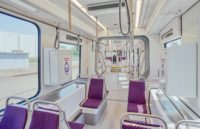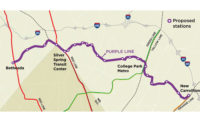Maryland Gov. Larry Hogan (R) has given his tentative approval to a 16.2-mile, 21-station light-rail Purple Line project across Washington, D.C.'s northern suburbs, but the go-ahead hinges on increased contributions from counties on the route and a revised funding strategy for a P3 project originally estimated to cost $2.4 billion.
In announcing his favorable decision on the Purple Line project on June 25, Hogan also delivered disappointing news to advocates of a second light-rail project, saying he isn't endorsing a proposed 14-mi. line in Baltimore.
Hogan has insisted since his election last fall that the Purple Line project had to be made more cost-effective to merit state participation.
He announced that Maryland’s share of the funding pie had been cut to $168 million from $700 mllion through design and operational changes, such as eliminating a second staging area and reducing railcar requirements.
In addition, Montgomery and Prince George’s counties, which the Purple Line would serve, are expected to contribute more to the project than their original combined total of $240 million.
The four private-sector consortiums already selected to bid on the design-build-operate-maintain project also will now be expected to offer cost-cutting suggestions in their final proposals, which must be submitted to the state in about 120 to 150 days. The Federal Transit Administration already has approved $900 million for the project, from its New Starts funding.
Hogan declined to approve a proposed 14-mile Red Line in Baltimore, saying that the $2.9-billion light-rail project “makes no economic sense.”
He was particularly critical of the project's lack of connectivity with the city’s other transit systems, and an estimated $1-billion tunnel that would be constructed through densely developed downtown areas.
Hogan did leave the door open, however, to reviving the Red Line if a more cost-effective approach could be developed.




